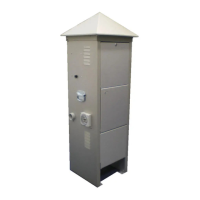Introduction HiVol 3000 User manual 1.7
6
concentration has been linked to adverse health effects. A PM
2.5
Size Selective Inlet
(SSI) is used to capture particulate matter less than 2.5 µm in diameter.
The Ecotech HiVol may be fitted with a TSP inlet, PM
10
or PM
2.5
SSI hoods. The
inlets are easily interchanged if required. The inlet hoods can be easily identified - the
TSP inlet is shaped like a pyramid and the SSI type is cylindrical in shape. The SSI
will be identified as PM
10
or PM
2.5
. Figure 1shows the TSP and SSI inlets.
The airborne suspended particles that pass through the inlet are collected on a pre-
weighed filter, during a pre-determined sampling period that is programmed into the
HiVol by the operator. The filter collects the airborne particles for subsequent
analysis. The HiVol controls the flow-rate and records the sampling duration and
volume of air that has been sampled.
After the sampling period is complete, the filter is removed and re-weighed to
determine the concentration and/or composition of suspended particulate matter.
Concentration results are typically expressed in micrograms per cubic metre (µg/m
3
)
of air sampled at Standard Temperature and Pressure (STP) conditions.
Acceptable levels have been established to govern the amount of airborne particulate
of a particular size and composition that may pose a health hazard to humans.
1.4.3 Sampling method
The HiVol 3000 is designed primarily as a particulate sampler. The HiVol pump and
flow controller draws a constant flow rate of ambient air through a specially prepared
filter.
The air-borne suspended particles are collected on the pre-weighed filter over a pre-
determined period. After sampling the filter is removed and re-weighed to determine
the concentration of particulate matter (TSP, PM
10
or PM
2.5
).
The total volume of air can be calculated from the flow-rate multiplied by the
sampling time. Results are expressed as micrograms per cubic metre of air sampled
(µg/m
3
), calculated at standard (or reference) conditions of temperature and pressure
(STP). The display on the control panel of the HiVol 3000 indicates the volumetric
flow rate of air, and computes the sample volume corrected to STP conditions which
means that no additional calculations are required during normal operation. This gives
the HiVol 3000 an advantage over other hi-vol types that control mass flow rate.
Volumetric flow control ensures that the Size Selective Inlet is always operating at the
desired flow rate. Automatic correction to reference conditions eliminates average
seasonal temperature and pressure corrections. This eliminates two sources of error
that could otherwise introduce significant inaccuracies, and additional calculations.
The STP Reference conditions can be programmed into the HiVol. The
Australian/European Standard Temperature and Pressure (reference) conditions are
0°C (273.15K) and 101.3 kPa. In the United States, reference conditions are 25°C
(298.15K) and 101.3 kPa. The HiVol must have the correct STP Reference conditions
entered in the Setup menu, in order to report the “Corrected Sample Volume” to the
appropriate reference conditions.
The HiVol 3000 can sample TSP or can utilise optional SSI to restrict the sampled
particulate to being that of a designated size or smaller.

